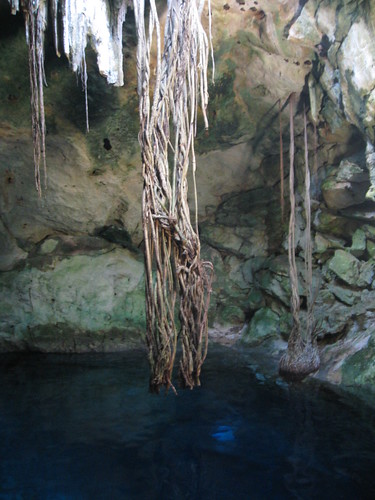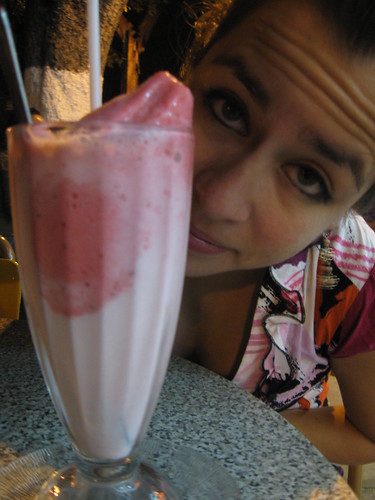Day 3: Cenotes

As I said in my write-up of Day 2, there is a very particular geology in the Yucatán peninsula that has not allowed the formation of many inland lakes or rivers. Instead, there is a subterranean fresh water system that runs through the porous rock. Back in 2005, my family came down to Mexico and we stayed in Xcarét just south of Playa del Carmen on the Mayan Riviera, and one of our day trips was to an underground river (where I got mild hypothermia from assisting my dad in the chilly water, but that’s another story), and we also visited a couple of cenotes. Cenotes is a Spanished-up version of the Mayan word dzonot, and in English, I guess you would call them underground wells or maybe sinkholes. Growing up in Michigan, I’ve seen my fair share of beautiful lakes, ponds, and rivers, but nothing compares to a cenote. Some are open to the air and look like deep ponds, others are partially underground with large vents to the outside, and others are completely underground. The latter are like something out of a movie; an underground cave with shafts of light just barely illuminating sapphire blue water that is crystal clear all the way to the bottom, often more than 50 feet deep. They have their own ecosystems and are all a part of a vast network of underground rivers and tributaries that penetrate the entire peninsula. Due to the fact that they were the only ready source of fresh water other than rain, the Mayans considered them sacred. Their sheer beauty makes me inclined to agree.
Within driving distance of Mérida, there are literally hundreds of cenotes, some accessible, some not. We drove to a town called Cuzamá, which is purported to have 135 cenotes around it, to visit three main cenotes; Chelentún, Chansinic’ché, and Bolonchoojol. The tour consists of a horse-drawn cart that runs down narrow train tracks formally used to transport materials during the time of henequen production. (Henequen is a cactus that is used to make the material known as sisal, which during the industrial revolution and throughout the turn of the last century was a material in very high demand for the strong ropes it can make. Mérida became a very wealthy city because of the henequen trade. Well, that is to say, hacienda owners in Mérida were rolling in dough while people of indigenous descent broke their backs growing, harvesting, and processing the stuff.) For 200 pesos (about $16) four people get transported on one of these carts to visit each cenote for 30 minutes. It is a bone-jarring, three hour trip in total and worth every penny. Did I say it was bone-jarring? Hard to overemphasize that fact. If I close my eyes, I can still feel the rattle of the old cart on the even older tracks. Let’s just say it’s not a trip for anyone with back problems.
It was also hilarious that every time we came across another cart, which wasn´t too often due to the small number of tourists, our guide would say in his Yucatán drawl, "Hay que dar paso." Just that. Basically, "Gotta let ´em through." This simple statement would be followed by the even simpler act of us getting off of the cart and the two guides picking it up off of the tracks and setting it down out of the way. We´d wave at the passing guides and tourists, they´d pick up the cart, put it back on, and we were off. Got a smile out of the four of us every time.
When we arrived, we saw an American couple packing up a bag from the back of their car, and we both figured that they would be our travel companions as there was literally no other tourist there. Maru and I weren’t sure what type of gringo tourist these two were going to be, but as soon as I said “Good morning” to the man, Russ, he threw me a big smile, and I had a good feeling, which was not at all unfounded. Russ and his wife Leanna are a retired couple from San Francisco who moved to Mérida last spring. They proved to be the perfect travel companions. We ended up eating with them afterwards and even going to their house for some drinks while we were in town.
The first cenote was gorgeous with lots of fish to look at and a long stretch to swim in. As soon as we arrived, the other tourists who were there were leaving, so we had it to ourselves for the majority of the time. Our guide ended up taking us to what is normally the last stop as our second stop to take advantage of the sun since it was partially cloudy. Once we got there, we understood what he was talking about. This cenote is completely underground. You have to descend a ladder down a hole to get to it, which is a little scary, but once you’re there you realize you would have gone down a ladder twice as long to see something so unique and captivating. About halfway through our time in this cenote, some very loud tourists came in, so we were quickly encouraged to go, which ended up being perfect for the last cenote of the day, because the four of us were completely by ourselves for virtually the entire time. Russ and I worked on our dives, and we all just enjoyed the peace, quiet, and beauty of the place.
Reluctantly, we packed up and left the last cenote and boarded our cart for thirty minutes of shaking and jarring to get back to base where we all had a beer in the parking lot and chatted for a bit. We decided to keep the conversation going at lunch, so we got a tip on where to go from the guides and headed to the town of Acanceh to eat at a large restaurant for tourists that ended up being really good. Everyone got a free sopa de lima when we showed them the promotional flyer we brought with us, then Maru ordered pavo en relleno negro and the rest of us ordered queso relleno, all served quickly, good sized portions, and very tasty. The company was great too!
By the time we got back into town, it was getting dark. We bathed and got changed then went out for some yummy sorbet on the Paseo de Montejo and went to bed early to rest up for another long day.
Here are links to our pics from that day.



I am seriously jealous.
ReplyDeleteDoug D